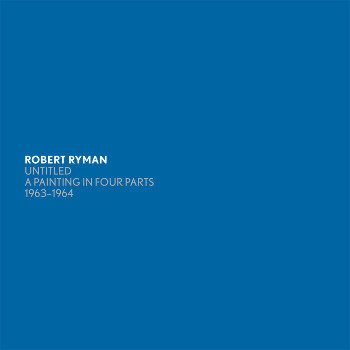Robert Ryman
30 Jul - 30 Aug 2012
ROBERT RYMAN
Untitled: A Painting in Four Parts, 1963–1964
30 July - 30 August 2012
...there is never a question of what to paint, but only how to paint. The how of painting has always been the image—the end product.
—Robert Ryman
Gagosian Gallery is pleased to present four paintings by Robert Ryman.
Ryman’s principal concern over the decades has been the ontology of painted surface in relation to its underlying support. He considers this relation to be highly performative in nature, often referring to the support as the “stage.” This ongoing investigation has yielded infinite visual possibilities without resort to images, implied spaces or manipulations of framing. In all his paintings the outer edges of the support are left bare and unpainted, so there is no doubt as to its equal importance. His works are typically square in format, and use white paint laid over partially visible, darker colored grounds.
Ryman has used a wide variety of paints since the 1950s, from gloss and semi-gloss to matte, from thin to viscous, and he handles them in many different ways to subtly nuanced effect. His supports range similarly, from industrial metal to linen to canvas, and finally to the wall itself. The wall, the light quality and the overall spatial confines each play an active role in the experience and meaning of Ryman's works, whatever their size and no matter what the interaction between paint and support.
In this group of four untitled paintings from 1963–1964, Ryman explores the nuanced effects of acrylic paint on aluminum. Textural variations serve as a map of the tools and gestures used in their making—crisscrossed grey patches of thick impasto contrast with silky, opaque squares and swathes of primary blue, yellow and teal. Sheer grey paint partially covers the aluminum surface, where muted fluctuations in saturation and shimmering glimpses of the raw support alter tone and texture. Looking at the surface of these paintings is to become totally immersed in their compositions, interplay of gestures, and improvisations. It is the existential physicality of Ryman’s paintings that impresses—their simple insistence on being.
Robert Ryman was born in Nashville, Tennessee in 1930. He studied at the Tennessee Polytechnic Institute and the George Peabody College for Teachers, Nashville. He began to paint while working as a guard at the Museum of Modern Art, New York in 1953. Solo exhibitions include the Dia Art Foundation (1988); “Robert Ryman,” The Tate Gallery, London (1993, traveled to the Centro de Arte Reina Sofia, Madrid, the San Francisco Museum of Modern Art, and the Walker Art Center, Minneapolis through 1994); and “Robert Ryman at Inverleith House,” Royal Botanic Garden, Edinburgh Scotland (2006). His work has been included in Documenta (1972, 1977 and 1982); the Venice Biennale (1976, 1978, 1980); the Whitney Biennial (1977, 1987, 1995); and the Carnegie International (1985, 1988). A permanent installation of Ryman’s paintings opened at Dia: Beacon in 2003. Ryman lives and works in New York and Pennsylvania.
Untitled: A Painting in Four Parts, 1963–1964
30 July - 30 August 2012
...there is never a question of what to paint, but only how to paint. The how of painting has always been the image—the end product.
—Robert Ryman
Gagosian Gallery is pleased to present four paintings by Robert Ryman.
Ryman’s principal concern over the decades has been the ontology of painted surface in relation to its underlying support. He considers this relation to be highly performative in nature, often referring to the support as the “stage.” This ongoing investigation has yielded infinite visual possibilities without resort to images, implied spaces or manipulations of framing. In all his paintings the outer edges of the support are left bare and unpainted, so there is no doubt as to its equal importance. His works are typically square in format, and use white paint laid over partially visible, darker colored grounds.
Ryman has used a wide variety of paints since the 1950s, from gloss and semi-gloss to matte, from thin to viscous, and he handles them in many different ways to subtly nuanced effect. His supports range similarly, from industrial metal to linen to canvas, and finally to the wall itself. The wall, the light quality and the overall spatial confines each play an active role in the experience and meaning of Ryman's works, whatever their size and no matter what the interaction between paint and support.
In this group of four untitled paintings from 1963–1964, Ryman explores the nuanced effects of acrylic paint on aluminum. Textural variations serve as a map of the tools and gestures used in their making—crisscrossed grey patches of thick impasto contrast with silky, opaque squares and swathes of primary blue, yellow and teal. Sheer grey paint partially covers the aluminum surface, where muted fluctuations in saturation and shimmering glimpses of the raw support alter tone and texture. Looking at the surface of these paintings is to become totally immersed in their compositions, interplay of gestures, and improvisations. It is the existential physicality of Ryman’s paintings that impresses—their simple insistence on being.
Robert Ryman was born in Nashville, Tennessee in 1930. He studied at the Tennessee Polytechnic Institute and the George Peabody College for Teachers, Nashville. He began to paint while working as a guard at the Museum of Modern Art, New York in 1953. Solo exhibitions include the Dia Art Foundation (1988); “Robert Ryman,” The Tate Gallery, London (1993, traveled to the Centro de Arte Reina Sofia, Madrid, the San Francisco Museum of Modern Art, and the Walker Art Center, Minneapolis through 1994); and “Robert Ryman at Inverleith House,” Royal Botanic Garden, Edinburgh Scotland (2006). His work has been included in Documenta (1972, 1977 and 1982); the Venice Biennale (1976, 1978, 1980); the Whitney Biennial (1977, 1987, 1995); and the Carnegie International (1985, 1988). A permanent installation of Ryman’s paintings opened at Dia: Beacon in 2003. Ryman lives and works in New York and Pennsylvania.

